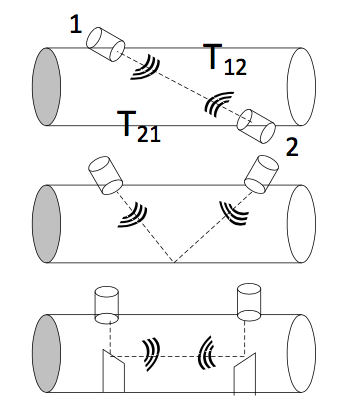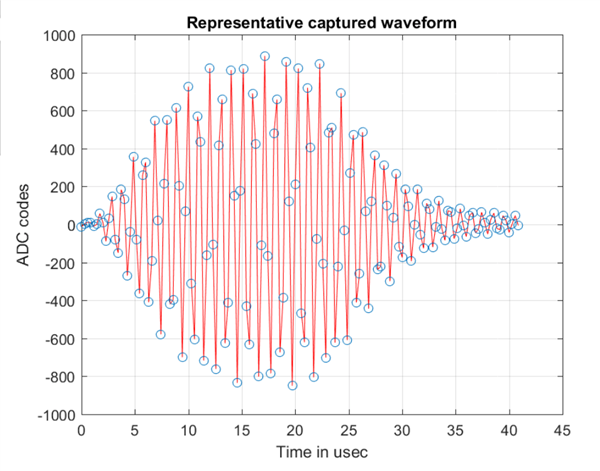SSZT867 november 2017 MSP430FR6047
Utilities around the world waste more than 30% of the water they pump and need a superior, affordable technology that can both find leaks and precisely measure water flow. Traditional mechanical paddlewheel-type water meters deteriorate and degrade over time. They also lack the modern electronics required for improved performance and connectivity for regular monitoring.
Ultrasonic sensing technology is gaining significant traction in this market. With no moving parts, ultrasonic sensing helps address static metering; its inherently low power consumption can help contribute to battery-operated system lifetimes of as much as 10 years or more.
In a water-flow measurement application, ultrasonic sensing measures the transit time difference between two sensors installed in a cross-section of a pipe. See Figure 1.
 Figure 1 Three Different Ultrasonic
Sensor Configurations.
Figure 1 Three Different Ultrasonic
Sensor Configurations.The sensors are piezoelectric transducers, which typically transmit sound waves from a few hundred kilohertz to megahertz, which is well above the audible frequency range. The delta time of difference between downstream (the direction of the flow) and upstream (against the direction of the flow) helps determine the flow rate. This technique is proven, since physical properties like temperature, pressure, composition of the medium and velocity do not change within the few milliseconds of measurement.
There are certainly challenges with this technology like the degradation of transducer characteristics, which results in impedance and frequency mismatch, signal changes due to air bubbles in the pipe, and liquid-composition changes with material impurities. These issues will affect measurement accuracy over time.
TI’s new high-speed analog-to-digital converter (ADC)-based technique enables complete waveform capture, facilitating robust and precise performance regardless of signal-amplitude variation and changes in transducer characteristics.
A correlation and interpolation technique digitally processes the captured waveform for upstream and downstream in order to derive the differential time of flight. This technique inherently helps reduce interferences and noise rejection with front-end filtering. See Figure 2.
 Figure 2 Captured ADC Waveform
Figure 2 Captured ADC WaveformThis solution offers the following features:
- A 25 ps zero flow drift enables minimum offset across the full industrial temperature range and the lowest flow-rate measurement (<1 liter per hour).
- A 32 ps single-shot standard deviation maintains accuracy across multiple or repeated measurements.
- A minimum time resolution less than 5 ps enables leak detection.
- Automatic gain control adapts to various transducer characteristics and does not require tuning for initial bring-up.
- A flexible software-based solution is compatible with multiple platforms ranging across different pipe sizes of DN15 to DN100 for both residential and industrial markets.
To learn more about this technique, see the MSP430FR6047 product page and read the white paper, Ultrasonic sensing technology for flow metering.